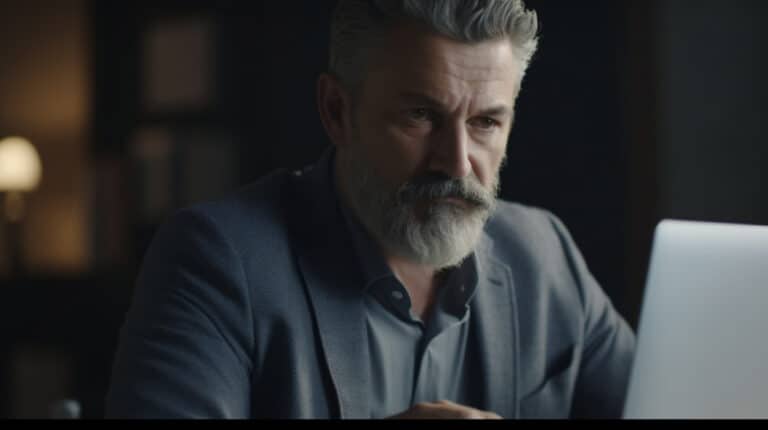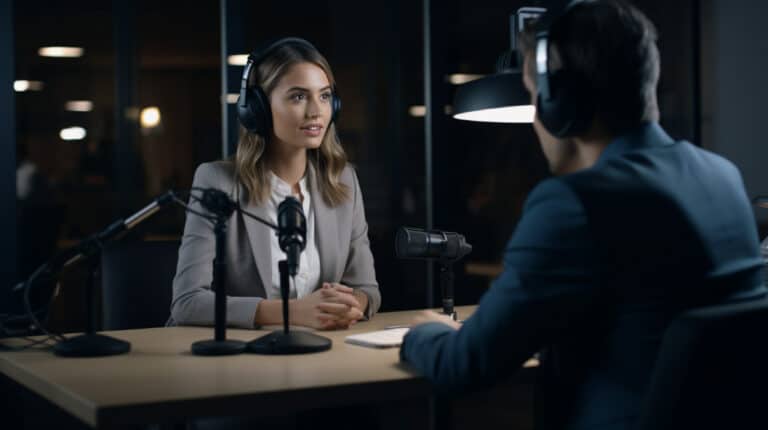How Can Businesses Use AI for Images?
Welcome, to the brave new world of artificial intelligence (AI) and its dazzling applications in image generation and editing.
As we navigate the digital seas of the 21st century, one thing is crystal clear: visual content is the reigning monarch of the marketing kingdom.
But how, you might ask, can businesses harness the power of AI to create eye-catching images that resonate with their audience?
Buckle up, because we’re about to embark on a thrilling journey into the heart of AI and image generation.
Demystifying AI and Image Generation
AI and image generation might sound like something straight out of a sci-fi novel, but I assure you, they’re as real as the device you’re reading this on.
At its core, AI is a constellation of technologies that enable machines to mimic human intelligence—learning, reasoning, problem-solving, perception and language understanding.
Now, when we sprinkle some of this AI magic onto the canvas of image generation, we get a powerful tool that can create visuals from scratch, edit existing images and even upscale low-resolution pictures to crystal clear quality.
As we stand on the precipice of this exciting frontier, the potential applications of AI in image generation are as vast as the digital landscape itself.
From creating personalised visuals for marketing campaigns to generating unique product images for e-commerce, the possibilities are virtually endless.
So, whether you’re a solopreneur, a small business owner, or at the helm of a large enterprise, there’s an AI tool out there that can cater to your specific needs.
In the next sections, we’ll dive deeper into the world of AI image generation, upscaling, editing and AI video tools.
So, stick around, because we’re just getting started!
The Magic of AI in Image Generation
Let’s pull back the curtain and reveal the magic of AI in image generation.
We’ll be putting three tools under the spotlight: Bing’s Image Creator, Leonardo.ai and Midjourney.
Each of these tools harnesses the power of AI to create stunning visuals, but they each have their unique features and benefits.
Let’s dive in and see what they have to offer.
Bing’s Image Creator
First up is Bing’s Image Creator, a tool powered by OpenAI’s DALL·E 2.
The interface is simple and you just describe what you want to create. From my testing, the images are very good and the written prompt doesn’t need to be overly elaborate.
For this comparison, the prompt was kept simple: “charcuterie board plating for a festive brunch”.
Bing produced 4 images for 1 credit and users get 100 free credits per day. You can also redeem Microsoft Rewards points for more boosts. This part is a bit confusing and not explained very well.
This is the best of the 4 images Bing created.

Leonardo.ai
Next, we have Leonardo.ai, an AI-driven platform that promises to generate production-quality assets for your creative projects.
This tool is designed to give you greater control over your generations, allowing you to create unique, production-ready images from pre-trained AI models or train your own.
It’s not just about image generation; Leonardo.ai is building an entire generative content production platform. The tool offers a canvas for editing your image and expanding it using AI, and the Community Feed is chock-a-block with amazing creations from users.
Typically, the more detailed the prompts, the higher the quality of the images produced by Leonardo. This tool is capable of generating a broad spectrum of artistic styles, making it a versatile choice for your creative needs.
Every image you generate with Leonardo costs a single token, and you’re allotted a daily quota of 145 tokens. The most affordable plan comes in at $10 per month, providing you with a generous 8,500 tokens.
To illustrate, using the same prompt as before, this was the best image out of the four I generated.

Midjourney
Last but certainly not least, we have Midjourney.
It is among the best options for creating AI art and is known for its impressive results. Unlike other AI art generators, MidJourney is self-funded and closed-source.
To tap into Midjourney’s capabilities, you’ll need to navigate through an app called Discord. While many AI artists hail this tool as the cream of the crop, the process of inputting prompts into Discord using the “/imagine” command, followed by additional parameters, can be a bit of a juggling act.
Midjourney doesn’t offer a free trial, instead, it operates on a subscription-based model to unlock its features. Subscription plans span from $10 to $60 per month, each offering varying degrees of image generation capabilities and bonus features.
In my personal experiment, I was able to generate roughly 300 images for the $10 fee, with 50 of them being truly outstanding.
A majority of the article images on this website were birthed from Midjourney.
Using the same prompt as the other two tools, Midjourney produced this very impressive image out of the four generated.

A Comparative Glance of AI Image Generators
Now that we’ve introduced our three contenders, let’s see how they stack up against each other:
- Ease of Use: Bing’s Image Creator takes the cake here with its straightforward, text-to-image functionality. Leonardo.ai offers an easy-to-use interface, although the prompting takes a bit more experimentation. While Midjourney’s system is a bit less user-friendly, once you get the hang of it you’ll be churning out amazing images at an astonishing rate.
- Features: Leonardo.ai shines in this department with its extensive features, including the ability to train your own AI models. Bing’s Image Creator, while simpler, does an excellent job at its core function of generating images from text. Midjourney, on the other hand, seems to rely on users learning from each other. Although, the continuous enhancements from the Midjourney team are consistently elevating the benchmark in the realm of AI imagery.
- Applications: Each of these tools have wide-ranging applications, from the creation of captivating marketing visuals to the generation of unique digital assets. The choice ultimately depends on your specific business needs and the level of control you wish to exert over the image-generation process.
Next up is image editing, whether it’s for a photo that needs sprucing up, an image for social media or some finishing touches to an AI creation that you have just generated.
Revolutionising Image Editing with AI
Prepare to be dazzled, as we dive into the vibrant world of AI-powered image editing. If you’ve ever spent hours trying to perfect an image, you’ll know that editing can be a painstaking process.
But with AI, image editing becomes a breeze! AI-powered editing tools can transform your images in a jiffy, making them look professional and eye-catching.
In this section, we’ll be exploring three such tools: Adobe Firefly, Canva and Fotor.
Each of these tools brings something unique to the table, and we’ll be looking into their features, benefits and pricing to help you choose the one that best suits your needs.
So, let’s dive in and discover the magic of AI in image editing!
Adobe Firefly: Unleashing Your Imagination
Adobe Firefly is a platform that allows you to unlock your creativity with the power of AI.
It offers various features such as text-to-image generation, generative fill, text effects, generative recolour and 3D-to-image generation.
The platform is currently exploring features like text-to-vector, text-to-pattern, text-to-brush, sketch-to-image and text-to-template. Even personalised results that are based on your own style or object are in testing.
Adobe Firefly is designed to be an experimental platform, allowing users to try out the latest in generative AI and provide feedback.
Canva: The All-in-One Design Solution
Canva is a graphic design app that allows users to create a wide range of visual materials such as social media graphics, videos, presentations, slides, posters and more.
It provides a vast array of customisable templates and royalty-free images to aid users in creating their designs.
The tool is designed to be user-friendly, with a gentle learning curve, making it accessible even to those without extensive graphic design experience.
Key Features:
- Templates and Elements: Canva offers pre-designed layouts (templates) for various applications and ‘elements’ which include royalty-free photos, videos and graphics that can be added to the templates. Users can also create custom templates.
- Ease of Use: Canva’s interface is intuitive and user-friendly. It allows users to pick a template, drop content into it, make tweaks and then export the design for use online or as a printed item.
- Importing Assets: Users can import their own images, videos, or audio to their Canva account. Custom fonts can also be added.
- Photo and Video Editing: Canva provides simple controls for editing photos and videos. It also includes a ‘background remover’ feature for photos and videos, and an ‘auto-adjust’ option for correcting image colours.
- AI Tools: Canva has introduced an AI feature, ‘Magic Design,’ that creates templates based on images uploaded by the user. Another AI-powered tool, ‘Magic Write,’ can automatically generate text content for documents based on a given title.
- Charts and Data Visualizations: Canva allows users to create up to 11 different types of charts and graphs. It also offers an integration with the ‘Flourish’ platform for creating interactive data visualisations.
- Exporting Projects: Designs or videos created in Canva can be exported to various formats like PNG, JPG, PDF, SVG, MP4, GIF, and PPTX.
- Brand Consistency: Canva provides a ‘brand hub’ feature that allows users to add a brand logo, define a colour palette, upload their own font, images, graphics and icons to ensure brand consistency across designs.
Benefits:
- Versatility: Canva can be used for a wide range of design tasks, from creating social media graphics to presentations, making it a versatile tool for businesses.
- Ease of Use: The platform is designed to be user-friendly, making it accessible to users without extensive graphic design experience.
- Cost-Effective: Compared to traditional graphic design tools, Canva’s pricing is considerably lower, making it a cost-effective solution for small businesses.
- Time-Saving: The availability of pre-designed templates and elements can save users a significant amount of time in the design process.
Canva offers three plans: Canva Free, Canva Pro, and Canva for Teams.
Canva Free is available for anyone wanting to design anything, either individually or collaboratively.
Canva Pro is aimed at individuals, solopreneurs and freelance designers, offering unlimited access to premium templates and more AI-powered design tools. Priced at $12.99/month per person.
Canva for Teams includes all the features of Canva Pro, tailored for teams of all sizes to collaborate effectively. Priced at $14.99/month per person.
Fotor: Your One-Stop Photo Editing Solution
Fotor is a versatile online photo editing and graphic design tool that offers a wide range of features to enhance, retouch and transform your images.
Key Features:
- Photo Editing Tools: Fotor provides a variety of photo editing tools that allow you to crop, resize and add text to your images. You can also create photo collages and graphic designs with ease.
- Background Remover: This smart tool enables you to remove backgrounds from images intelligently. It’s particularly useful for isolating subjects in portrait images or product photos.
- Photo Enhancer: With just one click, you can adjust the exposure, colours, contrast, sharpness and defog your pictures to enhance their quality.
- Collage Maker: Fotor offers various collage layouts and templates, allowing you to create aesthetic photo collages to showcase your images.
- AI Object Remover: This feature allows you to easily remove unwanted objects from your photos, resulting in a polished image.
- Photo Effects: Fotor provides a range of photo effects, including retro photo filters, vintage photo effects and art photo effects, to give your images different visual looks.
In addition to these features, Fotor also offers more advanced tools such as:
- red-eye removal
- reshape photos
- teeth whitening
- wrinkle remover
- straighten
- fine-tune
- blur tools
- exposure
- clone
- curve
It’s available on multiple platforms, including iOS, Android, Windows, and Mac, making it easy for you to edit images anywhere and anytime with a single Fotor account.
Fotor’s user-friendly interface and wide range of features make it a suitable tool for both beginners and professionals.
It’s an all-in-one solution for easy editing and better design. Fotor offers a basic version which is completely free, with more advanced features available in their paid plans.
With pricing options ranging from approximately $4 for 200 credits/month to around $24 for 2000 credits/month, there’s a plan to suit a variety of budgetary needs.
So, there you have it!
Three powerful AI-powered image editing tools that can transform your images and make them stand out.
Whether you’re a professional designer or a beginner, these tools can help you create stunning images with ease. So why wait?
Start exploring these tools today and unleash your creativity!
In the next section, we’ll take a closer look at how AI can take your images to new heights with upscaling. Stay tuned!
Taking Images to New Heights: Upscaling with AI
Fasten your seatbelts, dear readers, as we ascend to the lofty realms of AI image upscaling.
If you’ve ever tried to enlarge a photo only to be met with a blurry mess, you’ll know that upscaling images is no walk in the park. But fear not, for AI is here to save the day!
In this section, we’ll be exploring three such tools: Deep Image, Nero and Let’s Enhance.
So, hold on tight as we take off on this exciting journey into the world of AI image upscaling!
Deep Image: The Power of Precision
Deep Image is an AI-powered tool that specialises in enhancing photos with just a few clicks.
It’s designed to upscale images up to 5x, remove artefacts, correct colours and light, and even remove backgrounds.
This tool is a great choice if you’re looking to increase the size of your images without compromising on quality.
However, it’s important to note that the free download version comes with watermarks. For a watermark-free experience, you can opt for their pay-as-you-go plan starting at $1.99 for 5 credits or a subscription plan starting at $7.50 for 100 credits.
Nero: The Upscaling Virtuoso
Nero is an AI-powered platform that offers a unique photo experience.
It’s particularly known for its image upscaling feature, which allows you to increase the resolution of your images without losing quality.
However, the free version leaves watermarks on the upscaled images.
They provide 5 free credits daily, and their paid plans vary from a Day Pass at approximately $6, offering 20 credits per day, to a Yearly Plan at around $106, providing 3000 credits annually.
All plans remove the watermark on the processed images and give access to all of the AI tools.
Let’s Enhance: Quality Meets Versatility
Let’s Enhance is an AI tool that not only enhances and upscales images but also generates pictures from text.
It’s a great tool if you’re looking to improve the quality of your images and make them ready for any web and print format.
The free plan offers 10 free credits upon signing up, but images processed under this plan will have a watermark.
Their paid plans, ranging from $9/month to $34/month, offer more credits, additional features and remove the watermark on the processed images.
Lights, Camera, AI: Video with Artificial Intelligence
As we continue to explore the realm of artificial intelligence, we find that its applications are vast and varied.
One such area where AI has made significant strides is in the world of video creation and editing.
With the help of advanced AI tools, creating professional-grade videos has never been easier. Let’s delve into some of these tools and see how they’re revolutionising the video industry.
Nova A.I. – The Future of Video Editing
Nova A.I. is a comprehensive online video editing tool that leverages artificial intelligence to simplify and enhance the video editing process.
From automatic subtitle generation to text-to-speech conversion, Nova A.I. offers a range of features designed to make video creation a breeze.
The platform can translate your videos into 75 different languages, merge multiple video clips and even resize your videos to adapt to any social media player.
In partnership with iStock by Getty Images, Nova A.I. provides access to a vast digital asset library, including professional-quality stock footage, royalty-free audio and studio-quality images.
The platform also offers training for both large production studios and everyday content creators, making video editing accessible to everyone.
Nova A.I. presents a variety of pricing plans tailored to diverse user requirements.
For quick projects and short content, the “Free” plan is ideal, offering 30 minutes of subtitles, a 2GB upload limit, and a 10-minute upload/export length, all without the need for credit card details. However, videos come with a watermark.
For more extensive needs, the “Basic” plan at $10 per month provides simple video editing capabilities, including 150 minutes of subtitles/translation, unlimited upload file size, a 60-minute upload/export length, and access to 2 stock audio/video/images assets, among other features.
For professionals and teams regularly working with video and audio content, the “Professional” plan at $18 per month offers 300 minutes of subtitles/translation, a 150-minute upload/export length, and access to 4 stock audio/video/images assets.
Lastly, for companies managing large volumes of video and audio content, the “Business” plan at $55 per month provides 900 minutes of subtitles/translation, a 180-minute upload/export length, and access to 12 stock audio/video/images assets.
All paid plans offer unlimited upload file size, ample storage, and SRT/VTT/TXT subtitles download capabilities.
Deep Brain – AI-Powered Video Creation
Deep Brain by AI Studios provides a unique approach to video creation by using AI avatars.
This platform allows you to create videos by simply preparing a script and using their Text-to-Speech feature.
The platform is intuitive and easy to use, even for beginners, and it significantly reduces the time and cost involved in video preparation, filming and editing.
AI Studios offers a hyper-realistic AI avatar video service that has been praised by 50,000 satisfied users for its efficiency in terms of time and budget.
They offer a range of plans to cater to different user needs. For those wanting to test the waters, a free option allows the creation of a 10-second video.
For more extensive needs, the Starter plan, priced at $30 per month, provides a total of 10 minutes of video per month, with up to 10 minutes per video and 6 scenes per video. This plan boasts a variety of AI avatars, supports over 80 languages and voices and produces videos without a watermark.
For those ready to dive deeper, the Pro plan at $225 per month offers a total of 90 minutes of video per month, with up to 20 minutes per video and 25 scenes per video. It includes all the features of the Starter plan, plus priority video processing and API access.
Finally, for long-term professional use, the Enterprise plan offers custom pricing and includes all the features of the Pro plan, with the added benefits of up to 50 scenes per video, a custom AI avatar and 24/7 priority support.
It’s important to note that each credit, which is equivalent to 400 characters or one minute of video, is the unit of measure for these plans.
Pixop – Remaster Your Videos with AI
Pixop is a cloud-based platform that uses AI and machine learning to enhance and upscale videos.
With Pixop, you can remaster your digital masters from SD all the way to UHD 8K without the need for expensive hardware or complicated setups.
Pixop’s automated filters can sharpen, de-blur, de-noise, upscale, or change the frame rate of your video presentations, making it an ideal tool for creating impressive video resumes, webinars, pre-recorded media appearances, and more.
Pixop offers a flexible, pay-as-you-use pricing model, eliminating the need for subscription fees.
Users simply pay for what they use in processing, which is priced per gigapixel, and for utilities, which are priced per gigabyte.
To help users estimate costs, Pixop provides a handy calculator on their website.
This tool gives a general idea of the costs associated with processing footage. The cost at each step is determined by the number of gigapixels produced, which is calculated by multiplying the output resolution by the number of frames processed.
For example, the calculator assumes standard definition (SD) input footage at 25 frames per second (fps) for its estimates.
Creating Lifelike Headshots and Characters: The AI Advantage
In the world of digital imagery, the creation of lifelike headshots and characters has always been a challenging task.
But with the advent of AI, this task has become a breeze.
AI has the power to transform simple selfies into professional headshots, and the results are nothing short of impressive.
Let’s dive into two tools that are making waves in this space: LucidPic and Aragon.
LucidPic: Crafting AI Personalities
LucidPic is an AI person generator that allows you to create an AI person in seconds. You can adjust clothing, hair, style and even age to get the perfect image.
This tool is perfect for generating high-quality stock photos of people that don’t exist, and the best part is, they’re royalty-free.
LucidPic’s interface is straightforward and user-friendly. You simply select your desired filters, such as style, pose, sex, ethnicity, age, expression, hair colour, hair length, clothing and place, and then let the AI do its magic.
In no time, you’ll have a unique, AI-generated person ready to use in your projects.
The Basic plan is priced at $4 per month and includes 500 generations per month, commercial usage rights, private image storage, access to a wider range of styles, HD upscaling and priority support.
For those seeking unlimited generations, the Pro plan is available at $20 per month. In addition to unlimited generations, it also includes everything in the Basic plan.
Aragon: Your Personal AI Photographer
Aragon is a game-changer in the world of AI-generated headshots.
It transforms your selfies into professional headshots, saving you the time, energy and money you would otherwise spend on a professional photoshoot.
To use Aragon, you need to upload at least 12 images of your face. Selfies work great for this.
Once you’ve uploaded your images, Aragon’s AI gets to work and creates custom AI headshots within 90 minutes. You can then review your 200+ headshots and download your favourites.
Aragon offers three pricing plans: $29 for 40 images, $39 for 80 images and $69 for 200 images.
Each plan offers a different number of high-quality headshots and styles, with faster turnaround times for the higher-priced plans.
Aragon’s technology is powered by leading AI researchers from Google and Microsoft, ensuring high-quality results.
Plus, if you’re not completely satisfied with your AI-generated headshots, Aragon offers a full refund within 30 days of purchase.
So, whether you’re looking to revamp your LinkedIn profile, boost your job application, or upgrade your company’s site, AI-powered tools like LucidPic and Aragon offer a convenient, cost-effective solution.
They’re reshaping the way we create and use headshots and characters, making professional-quality imagery accessible to everyone.
Case Study: Crafting the Perfect Image with AI
In the world of AI, the possibilities are endless.
To illustrate this, let’s break down a personal project I recently undertook. The mission?
To create a unique Father’s Day card for my dad, a military aircraft enthusiast. The goal was to transform him into a World War II pilot, using nothing but AI tools.
Here’s how I did it.
Step 1: Setting the Scene with Midjourney
The first step was to create the original image. For this, I turned to Midjourney, an AI art generator known for its impressive results. After generating around 20 images, I finally landed on one that worked well with the reference image of my dad.
Step 2: Face Swapping with Insight FaceSwap Bot
Next, I needed to replace the face in the image with that of my dad’s. To accomplish this, I used the Insight FaceSwap bot. This tool uses AI to seamlessly swap faces in images, creating a realistic and convincing result.
Step 3: Colourising with Palette
The best image that worked happened to be in black & white. To bring it to life, I used Palette to colourise the image. Palette’s AI editing prompt provided the best colours, and I was able to download the SD image for free.
Step 4: Editing with Fotor
With the image now in colour, it was time for some fine-tuning. I used Fotor to adjust the contrast and colour grading. Fotor’s user-friendly interface and wide range of features made it easy to enhance the image to my liking.
Step 5: Upscaling with Let’s Enhance
The final step was to upscale the image for a clean, crisp finish. For this, I used Let’s Enhance. This AI-powered tool allowed me to upscale the image without losing any quality, resulting in a high-resolution image perfect for printing on a card.
And voila! With the help of these AI tools, I was able to create a unique and personalised Father’s Day card that my dad absolutely loved.
This process not only showcased the power and versatility of AI in image creation and editing but also allowed me to create something truly special for my dad.
Here are the steps for this process:

This case study serves as a testament to the power of AI in image creation and editing.
Whether you’re a solopreneur, a small business, or a large enterprise, AI tools can help you create stunning visuals that resonate with your audience.
How are AI-Generated Images Used in Marketing?
In the ever-evolving world of marketing, standing out from the crowd is paramount. And what better way to do that than with stunning, unique visuals?
Enter AI-generated images. These aren’t your run-of-the-mill stock photos. They’re custom-made, high-quality and tailored to your brand.
But how exactly are they used in marketing? Let’s delve into it.
Personalised Visual Content
Personalisation is the name of the game in modern marketing. With AI-generated images, you can create visuals that resonate with your target audience on a personal level.
For instance, you could use a tool like Midjourney to generate images that reflect your audience’s interests, preferences, or even their location. This level of personalisation can significantly boost engagement and conversion rates.
Enhancing Product Visuals
A picture is worth a thousand words, especially when it comes to showcasing products. AI tools like Fotor can help you enhance your product visuals, making them more appealing and enticing to potential customers.
Whether it’s adjusting the contrast, removing the background, or adding a touch of colour, AI can help you create product images that truly pop.
Creating Marketing Videos
Videos are a powerful marketing tool, and AI can help you create them more efficiently. With tools like Nova A.I., you can easily create, edit and enhance marketing videos.
Whether it’s adding subtitles, translating content, or merging video clips, AI can streamline the video creation process, saving you time and resources.
Crafting Unique Brand Images
In a sea of generic stock photos, AI-generated images can help your brand stand out. Tools like Aragon and LucidPic allow you to create custom AI avatars and headshots that reflect your brand’s personality and values.
These unique visuals can help you establish a strong brand identity and connect with your audience on a deeper level.
Upscaling Images for High-Quality Prints
If you’re creating marketing materials for print, image quality is crucial. AI tools like Nero can upscale your images without losing any quality, ensuring that your print materials look professional and high-quality.
AI-generated images offer a wealth of opportunities for marketers. They can help you create personalised, high-quality and unique visual content that resonates with your audience and sets your brand apart. So why not give it a try?
With the right AI tools, you might just find that creating stunning marketing visuals is easier than you think.
Navigating the Legal Landscape of AI-Generated Images
As we delve deeper into the realm of AI-generated images, it’s crucial to understand the legal implications that come along with it.
The legal landscape surrounding AI-generated images is a complex one, with laws and regulations trying to keep pace with technological advancements.
Copyright and Ownership
In the realm of copyright and ownership, the landscape for AI-generated imagery is still evolving.
In the United States, the copyright status of AI-generated art hinges on the degree of human creative input. If a human can demonstrate a significant contribution to the final product, the art may be eligible for copyright.
However, the U.S. Copyright Office has also stated that AI-generated images, being products not of human authorship, are not protectable under current copyright law. They will consider content created using AI if a human author has added something beyond the machine’s direct output.
Meanwhile, in Europe, the copyright landscape is also shifting.
Companies that use generative AI tools, such as ChatGPT, are required to disclose any copyrighted material used in the development of their systems. The European Commission has proposed new copyright rules specifically for generative AI.
However, there’s no clear information on whether AI-generated images can be copyrighted in Europe.
In essence, the U.S. Copyright Office’s rulings on AI-generated images are somewhat contradictory, while Europe is in the process of establishing new copyright rules for generative AI, necessitating companies to be transparent about the copyrighted material used in their AI systems.
This is very much still a grey area, and laws will vary from country to country.
Fair Use and Licensing
Another important consideration is the concept of fair use. If an AI model is trained on copyrighted images, does the resulting AI-generated image infringe on the original copyright?
This is a complex issue, and the answer may depend on the specific circumstances, including the nature of the use, the amount of the original work used and the effect of the use on the market for the original work.
In addition, many AI tools operate under a licensing model. This means that when you use an AI tool to generate an image, you are often granted a license to use that image under certain conditions. It’s important to read and understand the terms of these licenses, as they can vary widely.
Privacy and Consent
Privacy is another key concern. If an AI model is trained on personal images, there could be privacy implications.
For example, deepfake technology, which uses AI to create realistic images or videos of people, has raised serious privacy and consent issues. It’s important to ensure that any images used to train an AI model are used with the necessary permissions and respect for privacy.
Looking Ahead
As AI technology continues to evolve, so too will the legal landscape. It’s important for businesses and individuals using AI-generated images to stay informed about the latest developments in laws and regulations.
Consulting with a legal expert can also be a good idea to ensure that you’re using AI-generated images in a way that respects copyright, privacy and other legal considerations.
Remember, while AI offers incredible opportunities for creativity and innovation, it’s essential to navigate its use responsibly and ethically.
Weighing the Pros and Cons: Using AI for Images
As with any technology, using AI for images comes with its own set of advantages and drawbacks.
It’s essential to weigh these pros and cons to make an informed decision about whether and how to incorporate AI into your image creation process.
The Upside
- Efficiency and Speed: AI tools can generate images quickly, saving you time and effort. This efficiency can be a game-changer, especially for businesses that need to produce a large volume of visual content.
- Cost-Effective: AI tools can be more cost-effective than hiring a professional designer or photographer for certain tasks. They also offer scalable solutions that can grow with your business.
- Creativity and Innovation: AI can generate unique and creative images that might not be possible with traditional methods. This can help your content stand out and capture your audience’s attention.
- Customization: Many AI tools allow for a high degree of customisation, enabling you to create images that align with your brand and meet your specific needs.
- Accessibility: AI tools are typically user-friendly and do not require advanced technical skills. This makes high-quality image creation accessible to a wider range of people.
The Downside
- Quality Variations: While AI can produce impressive results, the quality can vary. It may take several attempts to generate an image that meets your standards.
- Lack of Human Touch: AI-generated images lack the human touch that comes from a professional designer or photographer. This can sometimes result in images that feel less authentic or personal.
- Legal and Ethical Considerations: As we discussed earlier, using AI-generated images can raise legal and ethical issues around copyright, privacy and consent.
- Depersonalisation: While AI can create images quickly and efficiently, it can also lead to a depersonalisation of the creative process. The human element of creativity, with all its flaws and idiosyncrasies, can sometimes be lost.
- Over-Reliance on Technology: There’s a risk of becoming overly reliant on AI for image creation, which could limit your own creative skills and abilities.
AI offers exciting possibilities for image creation, but it’s not a one-size-fits-all solution. It’s a tool that can enhance your creative process, but it’s also important to understand its limitations and use it responsibly.
As always, the best approach is one that combines the strengths of AI with your own unique creativity and judgment.
Conclusion
As we’ve journeyed through the cosmos of AI and image creation, we’ve seen how this technology is revolutionising the way we create and interact with visual content.
From generating unique images to upscaling, editing, and even creating lifelike headshots and videos, AI is truly pushing the boundaries of what’s possible.
But like any good explorer, we’ve also navigated the potential pitfalls and challenges. We’ve considered the legal and ethical implications, weighed the pros and cons and reminded ourselves that while AI is a powerful tool, it’s not a substitute for human creativity and judgment.
So, where does this leave us? Well, as with any journey, the destination often depends on the traveller.
For some, AI might be a game-changer, opening up new possibilities for creativity and efficiency.
For others, it might be a useful tool to have in their arsenal, complementing their existing skills and resources.
But regardless of where you stand, one thing is clear: AI is transforming the landscape of image creation, and it’s an exciting time to be a part of this journey.
Whether you’re a solopreneur, a small business owner, or part of a large enterprise, there’s a whole universe of AI tools out there waiting to be explored.
So buckle up, fellow travellers. The future of image creation is here, and it’s powered by AI. As we continue to explore this brave new world, who knows what amazing sights we’ll encounter next?
They say that the only limit is our imagination. But with AI on our side, even our imagination isn’t the limit anymore.






